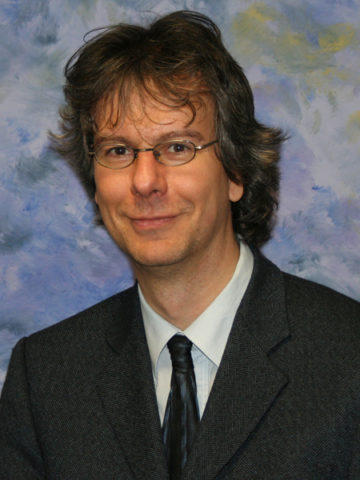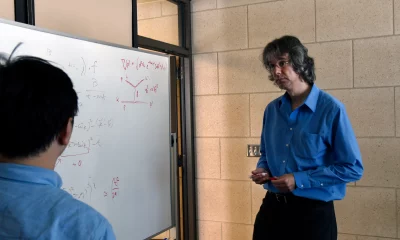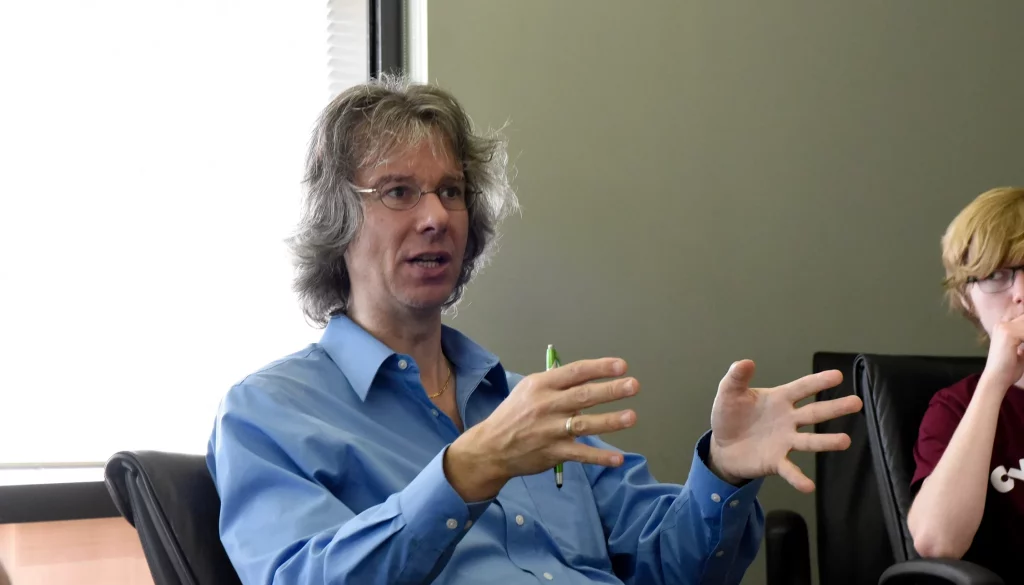Texas A&M Physicist Ralf Rapp Authors Most-Cited Paper in Nuclear Physics Journal’s Recent History
Three years ago this month, Texas A&M University physicist Ralf Rapp was first author on a paper that currently ranks as the top-cited article among all those appearing in the peer-reviewed Elsevier journal Nuclear Physics A during the past five years.
The paper, “Extraction of heavy-flavor transport coefficients in QCD matter,” summarizes the results of a Rapid Reaction Task Force — working groups that are funded by the ExtreMe Matter Institute (EMMI) at GSI Research Center in Darmstadt, Germany, to make significant progress on hot current topics in a variety of fields. Rapp served as the leader of the group, which featured four additional co-conveners corresponding to the first five authors on the paper that sought to explore the transport properties of the early universe.

Rapp, a University Professor in the Texas A&M Department of Physics and Astronomy and a member of the Cyclotron Institute since 2003, is an internationally recognized leader in high energy nuclear physics. He and his research group conduct theoretical studies of matter as it existed in the earliest moments of our universe and how it interacts at high temperatures and densities, based on the fundamental forces and properties of the strongly interacting matter that is formed in heavy-ion collisions.
During the past two decades, Rapp has made essential contributions in multiple areas of quantum chromodynamics (QCD), a theory of the strong force which predicts that, when heated to 2 trillion degrees or compressed to several times nuclear density, QCD matter no longer consists of the protons and neutrons that we are made of. Instead, it forms a plasma of free quarks and gluons, known as quark gluon plasma (QGP), that filled the universe during the first few microseconds after the Big Bang and may be present today in the cores of neutron stars. Rapp is among the world’s elite researchers investigating QGP through theoretical calculations that try to understand the results from major collaborative experiments that collide heavy nuclei at ultra-relativistic energies achievable with Brookhaven National Laboratory’s Relativistic Heavy Ion Collider (RHIC) and the Large Hadron Collider (LHC) at CERN.
“Without a doubt, Dr. Rapp is a world-renowned leader in the field of theoretical analysis of quark gluon plasma, the subject matter of this celebrated paper,” said Dr. Grigory Rogachev, professor and head of Texas A&M Physics and Astronomy. “His efforts are central to our understanding of this exotic state of matter that defined the first milliseconds of the universe’s existence. His genius and extremely hard work propelled him to the very top of his field, and the distinction of being the first author of the most-cited paper in Nuclear Physics A is a testament to that.
“In addition to his remarkable achievement in studies of the properties of heavy quarks and their bound states, or quarkonia, in QGP, Dr. Rapp has made several other seminal contributions and theoretical predictions which were then spectacularly verified experimentally. I am excited about his latest achievement, and I believe that there are many more to come.”
Five years ago, Rapp says his EMMI group’s goal was to achieve a better understanding of heavy-quark diffusion within the extremely hot nuclear-matter QGP phase measuring more than 100 million times the Sun’s surface temperature in which protons and neutrons dissolved into their elementary building blocks consisting of quarks and gluons that created more than 98 percent of the visible mass in the universe. By colliding heavy atomic nuclei at high energies, modern-day experiments seek to recreate the QGP within laboratory settings, including heavy quarks, or particles containing the heavy charm and bottom quarks that are believed to be excellent “Brownian Markers” of the QGP as it was formed in these heavy-ion collisions.

“In particular, the heavy-quark diffusion coefficient that describes their Brownian motion through the QGP is one of the key transport parameters that can be inferred by analyzing the corresponding experimental data,” Rapp said. “The results thus far confirm that the QGP is a very strongly coupled liquid, despite its record temperatures of more than two trillion degrees Kelvin — the largest ever produced in the laboratory.”
After successfully applying for and being approved for EMMI funding in 2015, Rapp says most of the field’s leading researchers gathered in July 2016 for an initial meeting, complete with preparatory homework assignments designed to give the various participating research groups the opportunity to apply their models and simulations to well-defined test cases that allowed them to better understand the common features and differences of the research approaches. After a follow-up meeting in December 2016, Rapp notes it took almost another year to write up and finalize the publication.
“It was a rather challenging process, having to assemble the researchers’ contributions and keeping up the momentum,” Rapp said. “I daresay that I pushed a lot in this phase, and that’s why in the end it was decided that I would be the first author.
“It is really gratifying to see it frequently cited now. It will probably remain the top-cited paper until the end of the year, at which point it will fall beyond the five-year timeframe criteria.”
To date, Rapp has more than 140 publications in referred journals — results that have been cited in excess of 13,000 times, with an h-index of 58. He has delivered hundreds of invited talks throughout the world, including plenary and summary talks at top-tier conferences and symposia, and written approximately 90 conference proceedings, most of which were also refereed. As a 2004 National Science Foundation CAREER Award recipient, his research has been continuously funded by NSF single-principal investigator grants ever since, attracting additional funding from the Humboldt Foundation, the Spanish Ministry of Education and Science, the National Natural Science Foundation of China and the U.S. Department of Energy National Nuclear Security Administration. A 2014 Fellow of the American Physical Society (APS), he was recognized along with his former graduate student X. Zhao with the 2009 Robert S. Hyer Graduate Research Award from the Texas Section of the APS.
Learn more about Rapp and his teaching, research and professional service accomplishments.
# # # # # # # # # #
About Research at Texas A&M University: As one of the world’s leading research institutions, Texas A&M is at the forefront in making significant contributions to scholarship and discovery, including science and technology. Research conducted at Texas A&M generated annual expenditures of more than $1.131 billion in fiscal year 2020. Texas A&M ranked in the top 25 of the most recent National Science Foundation Higher Education Research and Development survey based on expenditures of more than $952 million in fiscal year 2019. Texas A&M’s research creates new knowledge that provides basic, fundamental, and applied contributions resulting in economic benefits to the state, nation, and world. To learn more, visit Research@Texas A&M.
-aTm-
Contact: Shana K. Hutchins, (979) 862-1237 or shutchins@science.tamu.edu or Dr. Ralf Rapp, (979) 845-1411 or rapp@cyclotron.tamu.edu
The post Texas A&M Physicist Ralf Rapp Authors Most-Cited Paper in Nuclear Physics Journal’s Recent History appeared first on Texas A&M College of Science.
